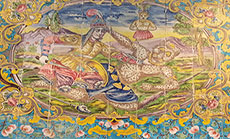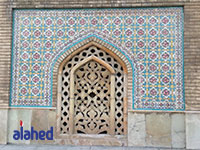
Outstanding World Heritage: Iran’s Golestan Palace

Elham Hashemi
The Golestan Palace (کاخ گلستان - in Persian) meaning the Roseland Palace, is the former royal complex of the Qajar, located in the Iranian Capital Tehran, which is one of the oldest monuments considered as a world heritage.
Built during the reign of King Tahmasp of the safavid Dynasty, (1502-1736), the palace was renovated during the Qajar dynasty by Karim Khan (1724-1797) and later in 1794, Agha Mohamad Khan chise Tehran as his capital, making the court of Golestan Palace the official residence of the royal Qajar dynasty and a few buildings were used as government bureaus while others used as museums to keep the valuable gifts the dynasty received. Most important was the use of this palace for the coronation of rulers during that time.
 During the Pahlavi era (1925-1979), the Golestan Palace was used for formal royal receptions, and the Pahlavi dynasty built their own palace at Niavaran (Niavaran Palace Complex). The most important ceremonies, held in the palace during the Pahlavi era, were the coronation of Reza Khan (1925-1941) in the Marble Throne (Takht e Marmar) and the coronation of Mohammad Reza Pahlavi (1941-deposed 1979) in the Museum Hall.
During the Pahlavi era (1925-1979), the Golestan Palace was used for formal royal receptions, and the Pahlavi dynasty built their own palace at Niavaran (Niavaran Palace Complex). The most important ceremonies, held in the palace during the Pahlavi era, were the coronation of Reza Khan (1925-1941) in the Marble Throne (Takht e Marmar) and the coronation of Mohammad Reza Pahlavi (1941-deposed 1979) in the Museum Hall.In between 1925 and 1945, a large portion of the buildings of the palace were destroyed on the orders of Reza Shah. He believed that the centuries old Qajar palace should not hinder the growth of a modern city. In the place of the old buildings, commercial buildings with the modern style of 1950s and 1960s were erected.
Golestan Palace Complex consists of 17 structures including palaces, museums, and halls. Almost all of this complex was built during the 200 years ruling of Qajarian kings. These palaces were used for many different occasions such as coronation and other important celebrations.
For instance, the Marble Throne is a spectacular terrace ornamented by paintings, marble-carvings and statues, tile-work, mirrors, woodcarvings, and other types of architectural art that prevails as well over the 17 buildings. The Marble Throne is one of the oldest buildings of the historic Arg. The architectural details, and other ornaments of the terrace, were completed during the reigns of Fath Ali Shah and Nasser el-Din Shah (1848-1896), who was known for his love to art.
Nasser el-Din Shah was very impressed by the exhibition of artifacts and valuable objects at European museums during his second European tour around 1872. He arrived back in Tehran intent on building a museum hall to exhibit paintings, royal jewels, and other royal artifacts.

The original collection of the Museum Hall is now scattered among Tehran's many museums. However, the paintings of the royal court are now kept at the Golestan Palace, with the European paints housed in the Pond House and the works of Iranian painters housed in the Picture House.
Coronations of Qajar kings, and formal court ceremonies were held on this terrace. The last coronation to be held at the Marble Throne was the coronation of the self-proclaimed king, Reza Khan Pahlavi, in 1925.
Works of European painters presented to the Qajar court are housed in the Pond House, in the Diamond hall and other places around the palace. The Pond House was used as a summer chamber during the Qajar era. A special cooling system pumped water form a subterranean system of streams, into small ponds inside the chambers.
The system was designed to pass through as many summer rooms as was necessary. The water was then channeled outside to irrigate the royal gardens. Due to the harmful effects of humidity, this system is no longer in use.
Meant to show the evolution of painting in Iran during the Qajar era, the works of Iranian painters are exhibited in two sections:
The Mirror Hall is the most famous of the palace halls. This relatively small hall is famous for its extraordinary mirror work. The hall was designed by Haj Abd ol Hossein Memar Bashi (Sanie el-Molk). Also, the Salam Hall (Talare Salam) was originally designed to be a museum. After the Sun Throne (Takht e Khorshid) was moved to the Royal Jewels Museum at the Central Bank of Iran, this hall was designated to hold special receptions in the presence of the king, hence the name Salam Hall.
 This hall has exquisite mirrors work. The ceiling and walls are decorated with plaster molding. The floors are covered with mosaic. During the reign of Nasser ol Din Shah, this hall was used to exhibit Iranian and European paintings alongside gifts presented to the Iranian court. Royal jewels were also exhibited inside glass cases. These jewels are now housed at the Royal Jewels Museum of the Central Bank of Iran. Tourists and envoys from European courts received in the Arg during the reign of Nasser el-Din Shah, spoke of this outstanding hall comparing it to its European counterparts.
This hall has exquisite mirrors work. The ceiling and walls are decorated with plaster molding. The floors are covered with mosaic. During the reign of Nasser ol Din Shah, this hall was used to exhibit Iranian and European paintings alongside gifts presented to the Iranian court. Royal jewels were also exhibited inside glass cases. These jewels are now housed at the Royal Jewels Museum of the Central Bank of Iran. Tourists and envoys from European courts received in the Arg during the reign of Nasser el-Din Shah, spoke of this outstanding hall comparing it to its European counterparts.The Edifice of the Sun (Shamsol Emare) is the most stunning structure of the Golestan Palace. The idea of building a tall structure came to Nasser el-Din Shah from pictorial images of European buildings. The Monarch wanted a structure from which he could have panoramic views of the city.
The building has two identical towers. The exterior views have multiple arches, intricate tile work and ornate windows. This building is a fusion of Persian and European architecture.
The building of Windcatchers (Emarate Badgir) was constructed during the reign of Fath Ali Shah. The building is flanked by two rooms known as "Gooshvar" (earrings). There is a central room which boasts the finest stained glass window in the Golestan Palace. Outside, there are four wind towers of blue, yellow and black glazed tiles and a golden cupola. The Windcatchers are constructed to allow the cooling wind move through the structure.
The Diamond Hall (Talare Almas) is located in the southern wing of the Golestan Palace, next to the building of Windcatchers. It is called "Diamond" Hall because of the exceptional mirror work inside the building.
The outstanding art of mosaic, the well-designed doors of allover the palace are unique and eye-catching in their little details and lively colors.
On 2013 June 23, the Golestan Palace was proclaimed as world heritage site by UNESCO.
Source: al-Ahed news



